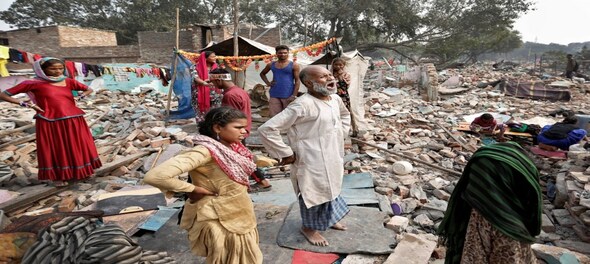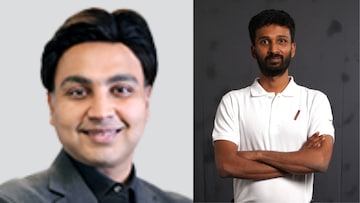
“Garib aadmi ko kaun dega? Lauta nai payenge toh koi dega loan?”
(Who will give the poor loans...they fear we cannot return it).
Sangita Devi lives with her husband, Arjun, and 7-year-old daughter in Chirkhund Village, Palamu. Arjun is a daily-wage worker but is often unable to work because of his epilepsy. In 2021, pushed to the brink by extreme hunger, Arjun sought work in Punjab. But he had to come back home within a month after a seizure at his workplace. With barely any savings to contribute, Sangita could not continue in her self-help group or ask them for a loan. The family has no Aadhaar or ration cards, cannot access the public distribution system for food, and cannot grow their own food as they have no land. While Sangita is eligible for a disability pension owing to an impairment in her right hand, she doesn’t receive the money.
Struggling for even two meals a day and stuck in an unending cycle, Sangita’s is among the 23 million rural Indian households satisfying at least three deprivation categories and variously referred to as ‘extremely poor’, ‘poorest of the poor’, or ‘ultra poor’.
‘Poorest of the poor’
Who are the poorest of the poor? Researcher Michael Lipton defines the ultra-poor or poorest of the poor as those who spend 80% of their total expenditures on food and cannot attain 80% percent of their standard caloric needs.
Poor households may struggle to make ends meet, but still have access to basic necessities and may be able to earn a living through informal employment or other means. Ultra-poor households, on the other hand, are often completely destitute and may lack the skills, resources and social networks needed to improve their situation.
Households in ultra-poverty have little or no assets, and in a majority of cases, live in remote rural areas with significant barriers to accessing education, healthcare and other essential services. They are also usually excluded from formal labor markets, making their earnings highly erratic. Further, many large-scale government livelihood programs and safety net programs aimed at the poor do not reach them.
Stuck in a poverty trap, unable to increase their earnings, ultra-poor families are now, and in the future, doomed to extreme poverty. Many of them don’t exist on paper and barely manage to exist in reality.
Need for a special strategy
Enabling the poorest of the poor families to come out of poverty and access livelihood schemes and government benefits requires a special strategy for two reasons.
First, the definition of ‘ultra-poor’ will differ between Indian states, each set in different contexts and facing unique challenges. While there can be a national-level, base criteria, the state governments are best placed to use these criteria to identify such families and then devise state-specific strategies that will address their issues directly.
Second, enabling the ultra-poor to break out of the poverty trap sustainably, requires multi-dimensional and carefully designed interventions, with the most promising approach being the Graduation Approach.
The Graduation Approach, a multifaceted and sequenced intervention, is a tested and evidence-driven approach to lift the poorest of the poor out of ultra-poverty. The program rests on the four pillars of social protection, livelihood generation, financial inclusion, and social development/empowerment. The program is centered on the intense hand-holding of women from the poorest of the poor households through motivated and trained field cadres. It includes a consumption or business stipend to provide ‘breathing space’ for the household to learn livelihoods activities, a ‘big push’ livelihood grant (either for agriculture, livestock, a small enterprise, or a combination), household-level enterprise planning and development support, access to rights and entitlements, access to food and nutritional security, access to health and education services and support through special institutions to address the unique challenges of the poorest of the poor.
Scaling up, gaining ground
While ground stories and studies, including one by Nobel Laureates Abhijit Banerjee and Esther Duflo*, show the Graduation Approach to be sustainable in the long-term, there are some obvious challenges, including the design’s resource-intensive nature, nascent funding support for the approach and the time it takes to demonstrate impact. The question arises, what will happen once hand-holding support to the families ends?
However, what is certain is that any such program with an aim to enable the poorest of the poor to step out of poverty can only be implemented and scaled up with government support, which is critical not only to reach populations in the remotest areas of this vast nation, but to also adapt programs to the various settings, contexts, and unique challenges each state and region brings.
What is also certain is that there is a need for a vibrant ecosystem of stakeholders — one in which state and central governments are the key players, and civil society organizations, funders, and philanthropies are the doers.
Together, such an ecosystem can gain ground in the fight against extreme poverty. Last year, 400 rural women, who were part of The/Nudge Institute’s End Ultra Poverty programs in Jharkhand’s Latehar, Lohardaga, and Gumla, graduated out of ultra-poverty.
“We now have three meals a day, have green vegetables as part of our meals, and we send our daughter to school” Anjani Birhod, a mother of two from Lohardaga shares, while talking about how the program impacted her family’s lifestyle.
These are the milestones that remind us that every step forward makes a difference.
At charcha '23 organized by The/Nudge Forum, India's foremost livelihoods summit, KPMG Global Services Pvt. Ltd. and The/Nudge Institute co-hosted sessions on rural livelihoods and best practices to end ultra-poverty.
Charcha is an initiative towards closing the distance between samaaj, sarkaar and bazaar, (society, government and markets) and was held in-person on Aug 23-Aug 24, at ISB, Hyderabad. Click here for more details
 NOTE | The authors of this article are Devang Bhandari, Global COO - ESG Advisory | Partner - Deal Advisory & Strategy | Corporate Citizenship Lead, KPMG Global Services Pvt. Ltd. and John Paul, Senior Director, End Ultra-Poverty, The/Nudge Institute
NOTE | The authors of this article are Devang Bhandari, Global COO - ESG Advisory | Partner - Deal Advisory & Strategy | Corporate Citizenship Lead, KPMG Global Services Pvt. Ltd. and John Paul, Senior Director, End Ultra-Poverty, The/Nudge Institute(This is a partnered post)
Note To Readers
No CNBCTV18 Journalist has worked on this article.
Check out our in-depth Market Coverage, Business News & get real-time Stock Market Updates on CNBC-TV18. Also, Watch our channels CNBC-TV18, CNBC Awaaz and CNBC Bajar Live on-the-go!


BJP's Hindi heartland dominance faces test in phase 3 polls
May 2, 2024 9:14 PM
Lok Sabha Election: Re-elections at a Ajmer booth after presiding officer misplaces register of voters
May 2, 2024 4:54 PM

